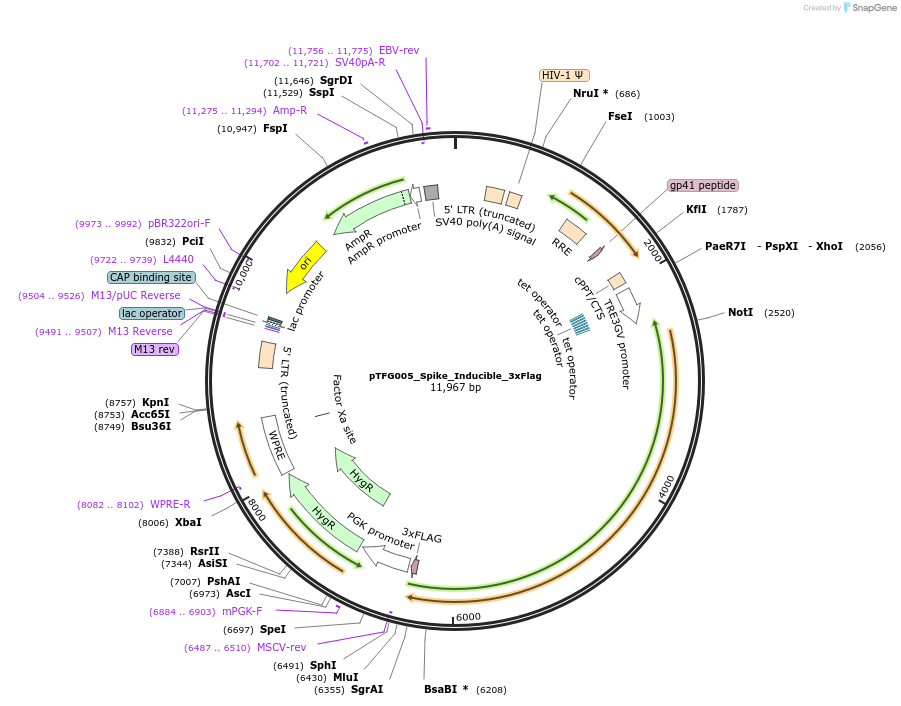pTFG005_Spike_Inducible_3xFlag
(Plasmid
#191578)
-
PurposeInducible expression of SARS-CoV-2 Spike protein with C-terminal 3x FLAG tag under TRE3G promoter and cloned into a 2nd generation lentiviral transfer plasmid (modified pLVX with Hygro resistance).
-
Depositing Lab
-
Sequence Information
Ordering
| Item | Catalog # | Description | Quantity | Price (USD) | |
|---|---|---|---|---|---|
| Plasmid | 191578 | Standard format: Plasmid sent in bacteria as agar stab | 1 | $89 | |
Backbone
-
Vector backbonepLVX-TRE3G
-
Backbone manufacturerClontech (Takara)
-
Modifications to backboneHygroR instead of PuroR.
-
Vector typeMammalian Expression, Lentiviral
-
Selectable markersHygromycin
Growth in Bacteria
-
Bacterial Resistance(s)Ampicillin, 100 μg/mL
-
Growth Temperature37°C
-
Growth Strain(s)NEB Stable
-
Copy numberHigh Copy
Gene/Insert
-
Gene/Insert nameSARS-CoV-2 Spike Protein
-
Alt nameSpike
-
SpeciesSynthetic
-
Insert Size (bp)3819
-
GenBank ID43740568
-
Entrez GeneS (a.k.a. GU280_gp02, spike glycoprotein)
- Promoter TRE3G
-
Tag
/ Fusion Protein
- 3x FLAG (C terminal on insert)
Cloning Information
- Cloning method Restriction Enzyme
- 5′ cloning site NotI (unknown if destroyed)
- 3′ cloning site MluI (unknown if destroyed)
- 5′ sequencing primer gcctggagcaattccacaacac
- (Common Sequencing Primers)
Resource Information
-
A portion of this plasmid was derived from a plasmid made byFang Li's lab. Spike sequence cloned from Addgene plasmid #145032.
Terms and Licenses
-
Academic/Nonprofit Terms
-
Industry Terms
- Not Available to Industry
Trademarks:
- Zeocin® is an InvivoGen trademark.
These plasmids were created by your colleagues. Please acknowledge the Principal Investigator, cite the article in which the plasmids were described, and include Addgene in the Materials and Methods of your future publications.
-
For your Materials & Methods section:
pTFG005_Spike_Inducible_3xFlag was a gift from Joshua Leonard (Addgene plasmid # 191578 ; http://n2t.net/addgene:191578 ; RRID:Addgene_191578) -
For your References section:
Elucidating Design Principles for Engineering Cell-Derived Vesicles to Inhibit SARS-CoV-2 Infection. Gunnels TF, Stranford DM, Mitrut RE, Kamat NP, Leonard JN. Small. 2022 May;18(19):e2200125. doi: 10.1002/smll.202200125. Epub 2022 Apr 7. 10.1002/smll.202200125 PubMed 35388947







